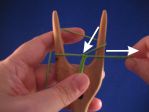- What type of yarn can I use?
- How much yarn do I need?
- Do I need several lucets in different sizes for different yarn?
- How do I know what lucet is good for me?
- Why is my cord too loose/too tight?
- I have a hard time grabbing the lower loop, what can I do?
- What to do when my wrist tires and my hand cramps?
What type of yarn can I use?
Especially in the beginning it is important that your yarn is smooth and strong. I teach with pearl cotton nr 8, because I happen to have a big bag of it, but e.g. crochet cotton works fine. Historic reenactors use silk, wool and linen and they are all fine if you choose smooth variants. When your technique gets better, even coarser wool works out as long as it can take the pulling. Note that very loosely spun yarn may split and give problems. If you don't need to be historically accurate, for example viscose works well and looks good and many acrylics work, too. If you keep your tension loose, you can experiment with novelty yarns like eyelash yarn. You can check out my samples.
How much yarn do I need?
I use the ratio 1:10 when figuring out how much yarn I need. E.g. a 25 meter skein of pearl cotton gives about 2.5 meters of cord. It is somewhat possible to switch to new yarn in the middle of a cord, but that always leaves some kind of a bump, so I prefer to make sure in advance that I have enough yarn to start with.
Do I need several lucets in different sizes for different yarn?
You can easily work with thin yarn on any lucet, even a very big one. The critical measurement is the space between the horns that has to fit the finished cord. It is also an advantage if there's some space for your fingers.

How do I know what lucet is good for me?
It is a matter of personal preference. I like a lucet that has a handle, is about 5 cm wide and has straight horns. Other people prefer a lucet with curved horns and without handle. Some people even like little lucets where you use a pick to lift the loop. To see what type of lucets there are, see my collection of wooden lucets and lucets made of other materials. You can even make your own e.g. by carving wood or as a 3D print.Why is my cord too loose/too tight?
It is easier to control the tension, if you lift the loop in two steps: first pull the lower loop away from the lucet (not upwards) until the loose loop in the middle disappears and only after that you lift the loop over the horn. (Click on the photos to see bigger versions.)
Watch a short video to see me do it. First away from the lucet, then upwards.
I have a hard time grabbing the lower loop, what can I do?
It is usually easier to grab the loop in front of the lucet and not at the horn in the side. If the lucet is very small, there might not be enough space, but most lucets allow for a bit of space between the finished cord and the horn so you can fit your thumb and index finger there.
I grab the loop in front of the lucet even when using a pickup stick, both when picking the loop up from below or from above.
What to do when my wrist tires and my hand cramps?
I use a lucet with the yarn in the right hand (see video of the technique). This makes it possible to hold the lucet very lightly and almost horizontally, as I do in this video. This position lessens the pressure on my left wrist. The lucet can have a handle, but it is not necessary, as long as the lucet is the right width so it rests nicely in the palm of my hand. I seldom use the bone lucets in my collection, because they are so small I have to hold them tightly and they are also somewhat slippery. My favorite lucets are about 5 cm wide and rounded around the edges. If your hand cramps when holding the lucet, the lucet may be wrong size or too slippery. You can't really change the size and shape other than by switching lucets, but if the varnish on a wooden lucet is very slippery, fine sandpaper can be used to make it coarser. It won't look as pretty, but works better when not too slippery.



